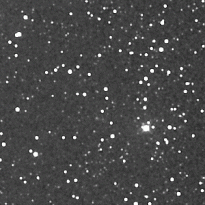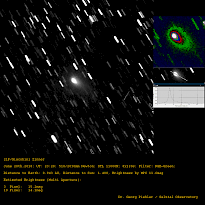21P Giacobini-Zinner
21P/Giacobini-Zinner was discovered by Michel Giacobini December 20th, 1900.
The orbital elements indicated that the comet was expected to return in 1907, but it was not observed. Ernst Zinner recovered the comet during an observation of some variable stars at October 23th, 1913.
It has an orbital period of 6.6 years and belongs to a group called "Jupiter-Family". The closest distance to the sun is currently 1.012792 Astronomical Units . Its core diameter is estimated to about 2km.
This year 21P will reach its perihelion about September 11th, 2018 and this is also the time it will reach its closest distance to the Earth with about 0.39 Astronomical Units. Predicted brightness by MPC is currently (May 18th, 2018) about 13.4 mag and it's predicted to get into about 7 mag in September 2018.
(source: Wikipedia & MPC)
In the night of May 18th, 2018 some observation time right before dawn was left and I used the "Friesenheimer Lichteimer" (20 Inch Newton) to search for it:
 |
21/P Giacobini - Zinner - May 18th, 2018, 01:55-02:07 UT
Friesenheimer Lichteimer (Newton 510/2030mm with ASA Corrector)
Bin=4, RGB-Green: 2*60s
Dark and Flatfield corrected
Selztal Observatory / Germany
Animated GIF - 21P Giacobini-Zinner can be detected close to the center.
|
 |
21/P Giacobini - Zinner - May 18th, 2018, 01:55-02:07 UT
Friesenheimer Lichteimer (Newton 510/2030mm with ASA Corrector)
Bin=4, RGB-Green: 11*60s co-added on comet
Dark and Flatfield corrected
Selztal Observatory / Germany
Estimated brightness is less than 15mag, compared to the prediction of the MPC i.e. based on pure ephermeris: 13.4mag
Distance Comet-Earth: 1.333 AU
Comet-Sun: 1.812 AU
|
Update: June 05th, 2018
 |
21/P Giacobini - Zinner - June 05th, 2018, 00:20-00 UT
Friesenheimer Lichteimer (Newton 510/2030mm with ASA Corrector)
Bin=1, RGB-Green: 10*60s co-added on comet
Dark and Flatfield corrected
Selztal Observatory / Germany
Estimated brightness is less than 14.8mag, compared to the prediction of the MPC i.e. based on pure ephermeris: 12.5mag. Core brightness about 15.9 mag (Aperture 3 pixel = 2.7")
Distance Comet-Earth: 1.333 AU
Comet-Sun: 1.812 AU
Meanwhile a small asymmetric extension of the coma can be identified at position angle of ~ 120° (North = 0). The size into this direction is about 40 Pixel equivalent about 36".
|
Update: June 20th, 2018
 |
21/P Giacobini - Zinner - June 20th, 2018, 23:28 UT
Friesenheimer Lichteimer (Newton 510/2030mm with ASA Corrector)
Bin=1, RGB-Green: 8*120s co-added on comet
Dark and Flatfield corrected
Selztal Observatory / Germany
Estimated brightness is less than 14.1mag, compared to the prediction of the MPC i.e. based on pure ephermeris: 11.6mag. Core brightness about 15.2 mag (Aperture 3 pixel = 2.7")
Distance Comet-Earth: 0.943 AU
Comet-Sun: 1.488 AU
|
Update: June 21th, 2018
 |
21/P Giacobini - Zinner - June 21th, 2018, 23:10 UT
Friesenheimer Lichteimer (Newton 510/2030mm with ASA Corrector)
Bin=1, RGB-Green: 17*120s co-added on comet
Dark and Flatfield corrected
Selztal Observatory / Germany
Estimated brightness is less than 13.7mag, compared to the prediction of the MPC i.e. based on pure ephermeris: 11.4mag. Core brightness about 15.1 mag (Aperture 3 pixel = 2.7")
Distance Comet-Earth: 0.933 AU
Comet-Sun: 1.489 AU
|
I'll try to keep tracking on development of brightness of this small comet.




